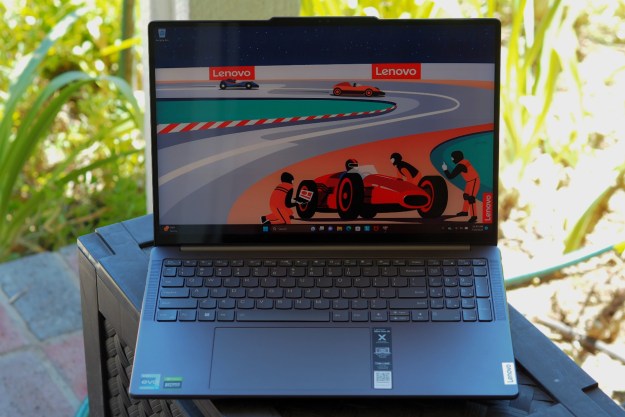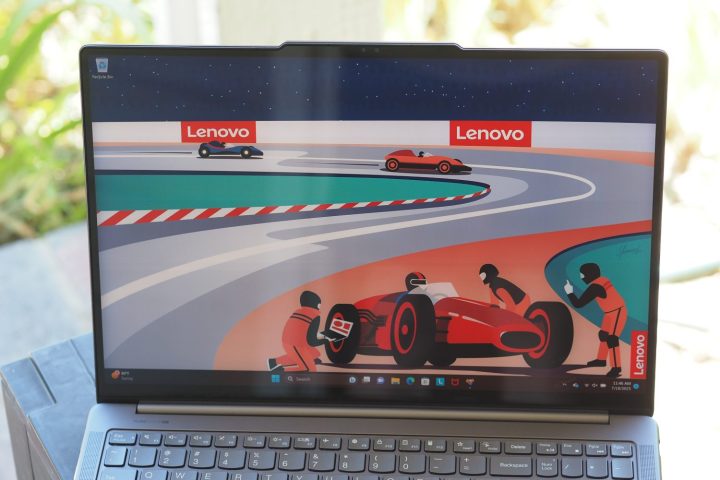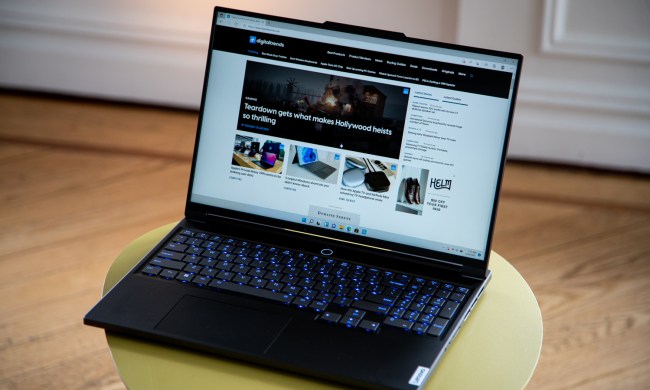
- Outstanding performance
- Good entry-level gaming
- Solid build
- Attractive aesthetic
- Great keyboard and touchpad
- Display contrast not optimized
- Poor battery life
Lenovo’s Slim 9i is one of my favorite laptops, offering style, build quality, and performance that falls just shy of making our list of best laptops. The company is clearly a fan as well because it just introduced a beefed-up version of the laptop. The Slim Pro 9i now has a larger, mini-LED display and much faster components inside, while retaining a similar design with smoothly rounded edges.
It’s not cheap, and for the price, I wish the battery lasted longer. But it’s a solid performer and remains one of the most premium Windows laptops you can buy.
Specs and configurations
| Lenovo Slim Pro 9i | |
| Dimensions | 14.27 inches x 9.64 inches x 0.71 inches |
| Weight | 4.92 pounds |
| Processor | Intel Core i9-13905H |
| Graphics | Nvidia GeForce RTX 4050 Nvidia GeForce RTX 4060 |
| RAM | 32GB LPDDR5X-6400Mhz |
| Display | 16.0-inch 16:10 3.2K (3200 x 2000) mini-LED touch, 165Hz |
| Storage | 1TB PCIe SSD |
| Touch | Yes |
| Ports | 1 x USB-C with Thunderbolt 4 2 x USB-A 3.2 Gen 1 1 x HDMI 1 x 3.5mm audio jack 1 x SD card reader |
| Wireless | Wi-Fi 6E and Bluetooth 5.2 |
| Webcam | 5MP with infrared camera for Windows 11 Hello |
| Operating system | Windows 11 |
| Battery | 75 watt-hour |
| Price | $1800+ |
Lenovo currently offers two versions of the Slim Pro 9i. My review unit is available at Costco with a . That gets you an Intel Core i9-13905H CPU, 32GB of RAM, a 1TB SSD, an Nvidia GeForce RTX 4050 GPU, and a 16.0-inch 3.2K mini-LED display. You can also get the same configuration with an RTX 4060 from the Lenovo store for $2,200.
That makes the Slim Pro 9 a premium laptop that’s around the same price as the Dell XPS 15. It’s expensive, but not egregiously so.
Excellent performance thanks to an optimized GPU

The Lenovo Slim Pro 9i packs a punch thanks to its 13th-gen Intel Core i9-13905H. That’s a 14-core (six Performance at 5.4GHz and eight Efficient at 4.1GHz), 20-thread CPU running at 45 watts. It offers the same cores and speeds as the Core i9-13900H that we’ve tested before, but it’s the fastest in our comparison group in our CPU-intensive benchmarks.
I ran the benchmarks in both balanced and performance modes, and the latter made a significant difference in a couple of our benchmarks. Lenovo did a great job with the thermal design because the laptop never runs hot and the fans spin up appropriately without getting too loud. The company calls its solution X Power, and it includes both fine-tuning of the fans and overclockable GPU and memory.
Where the Slim Pro 9i impressed the most was the Pugetbench Premiere Pro benchmark, which runs in a live version of Adobe’s Premiere Pro video editing application and can make use of the GPU to speed up various processes. Although the Slim Pro 9i had the slowest GPU in our comparison group, the entry-level Nvidia GeForce RTX 4050, it lost out only to the HP Envy 16 with its faster RTX 4060 GPU. And even then, the difference was minimal, particularly in performance mode.
Compared to the Acer Swift X 14 with a Core i7-13700H and an RTX 4050, which scored 835 and 849 in performance mode, the Slim Pro 9i is considerably faster.

Clearly, Lenovo tuned the GPU well and squeezed out every ounce of performance from the CPU. The Nvidia Studio drivers likely helped in the Pugetbench benchmark, and the Slim Pro 9i will handle extremely demanding productivity tasks as well as tackle serious creative workflows.
| Geekbench (single/multi) |
Handbrake (seconds) |
Cinebench R23 (single/multi) |
Pugetbench Premiere Pro |
|
| Lenovo Slim Pro 9i (Core i9-13905H / RTX 4050) |
Bal: 1,688 / 13,283 Perf: 1,667 / 13,884 |
Bal: 71 Perf: 63 |
Bal: 1,690 / 16,645 Perf: 1,691 / 18,085 |
Bal: 912 Perf: 1,114 |
| HP Envy 16 (2023) (Core i9-13900H / RTX 4060) |
Bal: 1,997 / 12,742 Perf: 1,992 / 12,645 |
Bal: 73 Perf: 75 |
Bal: 1,944 / 15,596 Perf: 1,954 / 15,422 |
Bal: 1,106 Perf: 1,121 |
| MSI Prestige 16 Studio (Core i7-13700H / RTX 4060) |
Bal: 1,880 / 6,951 Perf: 1,903 / 11,945 |
Bal: 139 Perf: 80 |
Bal: 1,797 / 7,959 Perf: 1,921 / 13,647 |
Bal: 668 Perf: 865 |
| Dell XPS 15 (9530) (Core i7-13700H / RTX 4070) |
Bal: 1,787 / 11,978 Perf: 1,830 / 11,769 |
Bal: 79 Perf: 76 |
Bal: 1,865 / 13,386 Perf: 1,868 / 13,927 |
Bal: 866 Perf: 1,023 |
| Dell XPS 17 (9730) (Core i7-13700H / RTX 4070) |
Bal: 1,901 / 12,654 Perf: 1,928 / 12,911 |
Bal: 79 Perf: 71 |
Bal: 1,933 / 13,384 Perf: 1,912 / 15,462 |
Bal: 760 Perf: 848 |
| Apple MacBook Pro 14 (M2 Max 10/38) |
Bal: 1,973 / 14,596 Perf: N/A |
Bal: 85 Perf: N/A |
Bal: 1,608 / 14,789 Perf: N/A |
Bal: 1,093 Perf: N/A |
With the entry-level RTX 4050 GPU, you shouldn’t expect more than basic 1080p gaming performance. As mentioned above, Lenovo did a great job of tuning the GPU, though, and the Slim Pro 9i is capable of running modern titles and 1080p as long as the graphical detail is tuned right. We haven’t tested many
It scored better than the Acer Swift X 14 in the 3DMark Time Spy test, for example, at 7,971 and 8,776 in performance mode compared to 5,927 and 6,741, respectively. And in Fortnite, the Slim Pro 9i hit 90 frames per second (fps) in performance mode at 1200p and epic graphics, compared to the Acer at 67 fps.
Unsurprisingly poor battery life
With a power-hungry mini-LED display and a very fast CPU, I wasn’t expecting great battery life. The relatively small 75-watt-hour battery (compared to 86-watt-hours in the XPS 15 and 100-watt-hours in the MacBook Pro 16) doesn’t help.
The results were as predicted. The Slim Pro 9i lasted just five hours in our web browsing test, 9.25 hours in our video looping test, and 7.25 hours in the PCMark 10 Applications battery test. The XPS 15 went for 9.75 hours, 11.75 hours, and 10.57 hours, respectively. The MacBook Pro 16 was incredibly impressive with 18.5 hours of web browsing and 23.25 hours of video playing.
You’ll need to take the large power brick along with you if you want to work on the road.
An elegant design made larger

As mentioned above, the original Slim 9i introduced a new design a couple of generations back that rounded the laptop’s edges and smoothed out the rest of the aesthetic. The result is a laptop that’s both elegant and comfortable to use. The Slim Pro 9i carries on that design philosophy, only in a larger chassis. It, too, has rounded edges for added comfort and its Storm Grey chassis is understated and looks as good as the best

The all-aluminum chassis is rigid, with no bending, flexing, or twisting in the lid, keyboard deck, or chassis bottom. It’s as sturdy a design as on the best

The keyboard is the same one you’ll find on most non-ThinkPad Lenovo
Connectivity is good, with a mix of Thunderbolt 4 and legacy ports to go with a full-size SD card reader, always a plus for creators. Wireless connectivity is up to date with Wi-Fi 6E and Bluetooth 5.1.
The webcam is a high-resolution 5MP version that provides an excellent image for videoconferencing. There’s an infrared camera for Windows 11 Hello support via facial recognition. The cameras can be physically switched off via a toggle on the side of the chassis, which also turns off logging in via Windows Hello. Lenovo also includes their Zero Touch user presence sensing technology, which will put the laptop to sleep when the user walks away and wake it up and log in when the user returns.
A mini-LED display held back by Windows

Apple was among the first companies to introduce
As you can see from our comparison table, the Lenovo display did better than the MSI panel in a few key metrics. It led the pack at a blinding 675 nits, the highest in our comparison group and among the highest brightness levels we’ve measured. The MacBook Pro display might be able to hit a higher brightness when displaying
Where the Slim Pro 9i fell short of both Apple’s mini-LED display and OLED was in its contrast, which hit 3,090:1. That’s better than IPS but not nearly as high as with the MacBook Pro or OLED displays in general. What was interesting, though, was that when I turned on
Clearly, the Mini-LED display in the Slim Pro 9i is capable of displaying much better contrast, but as implemented, at the cost of brightness and color quality. To me, this demonstrates that it’s most likely Windows that’s driving these results, and Apple has simply done a better job of tuning its displays in macOS. Note that the Slim Pro 9i’s display runs at up to 165Hz, which does make Windows a lot smoother.
In the end, the Slim Pro 9i display is good enough for all productivity work, does well with
| Brightness (nits) |
Contrast | sRGB gamut | AdobeRGB gamut | Accuracy DeltaE (lower is better) |
|
| Lenovo Slim Pro 9i (Mini-LED) |
675 | 3,090:1 | 100% | 88% | 1.24 |
| Lenovo Slim Pro 9i HDR (Mini-LED) |
509 | 35,600:1 | 96% | 73% | 2.19 |
| MSI Prestige 16 Studio (Mini-LED) |
455 | 3,140:1 | 98% | 82% | 3.46 |
| Apple MacBook Pro 14 (Mini-LED) |
511 | 35,450:1 | 100% | 89% | 1.21 |
| Dell XPS 17 9730 (IPS) |
501 | 1,570:1 | 100% | 100% | 1.33 |
| Lenovo Yoga 9i Gen 8 (OLED) |
395 | 27,510:1 | 100% | 96% | 0.79 |
| Apple MacBook Air M2 (IPS) |
486 | 1,310:1 | 100% | 90% | 1.08 |
An attractive entry in an important market
The Slim Pro 9i makes a solid entry into a class of
It doesn’t have the most powerful GPU, but Lenovo makes the most of it and it competes in creative apps with several




